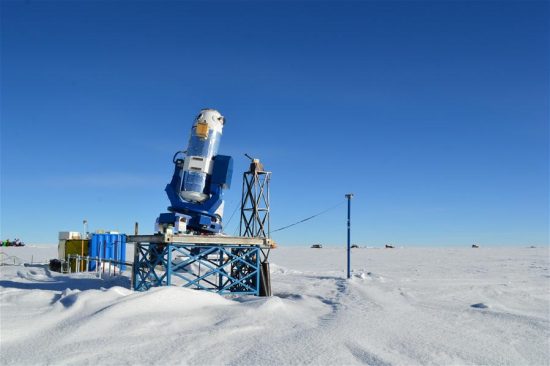
Photo taken on Dec. 30, 2016 shows Chinese telescope AST3-2. (Xinhua/Chinese Center for Antarctic Astronomy)
Chinese scientists on Monday announced observation of the "optical counterpart" of gravitational waves coming from the merger of two binary neutron stars using a survey telescope in Antarctica.
The gravitational waves were first discovered by the U.S.-based Laser Interferometer Gravitational-Wave Observatory (LIGO) detectors on Aug. 17. The Chinese telescope independently observed optical signals resulting from the merger the next day, among some 70 telescopes on the ground or from space across the world, according to the Chinese Center for Antarctic Astronomy.
It was the first time humans have detected gravitational waves and the corresponding electromagnetic phenomena resulting from a binary neutron star merger.
Data exclusively collected by the Chinese detector has led to a preliminary estimate of the ejecta parameters, according to Wang Lifan, director of the center.
The merging process ejected radioactive material with more than 3,000 times the mass of the Earth at a speed of up to 30 percent the speed of light, Wang said.
A merger of black holes with an extremely strong gravitational field can not generate ejecta or electromagnetic phenomena, according to Wu Xuefeng, a researcher with the Purple Mountain Observatory of the Chinese Academy of Sciences.
However, the collision of binary neutron stars is accompanied by a series of electromagnetic phenomena that are crucial to research in origins of heavy elements like platinum and gold.
"The crash of binary neutron stars is like a gigantic gold factory in the universe," said Jin Zhiping, an associate researcher with the observatory and a member of an international team that analyzed optical signals.
The host galaxy of the incident is located about 130 million light years from the Earth.
In 2015, LIGO detectors confirmed the existence of gravitational waves produced during the merger of two black holes, which were predicted by Albert Einstein's theory of general relativity 100 years ago.
So far, LIGO and its partners have discovered four cases of gravitational waves coming from mergers of two black holes.
The Chinese telescope is a catadioptric optical telescope with an entrance pupil diameter of 500 mm. Its unique location allows for continuous observations lasting longer than 24 hours during the austral winter.
China's first X-ray astronomical satellite, a Hard X-ray Modulation Telescope named Insight, also contributed to the detection.
Only two months after its launch, the satellite successfully monitored the space where the incident occurred.
Chinese scientists forecast that the next achievement in observation might be gravitational waves coming from the merger of a binary neutron star and a black hole. (Updated)
Read more:
10 facts about gravitation waves from neutron star merger
Scientists announced Monday that they have for the first time detected the ripples in space and time known as gravitational waves as well as light from a spectacular collision of two neutron stars.
Here are 10 key facts about the event known as GW170817, which triggered an international effort to observe the massive explosion that resulted from the collision.
Scientists' dream comes true with detection of gravitational waves from merging neutron stars
Scientists announced Monday that they have for the first time detected the ripples in space and time known as gravitational waves as well as light from a spectacular collision of two neutron stars.
The detection of the gravitational wave signal, called GW170817, was made at 8:41 a.m. EDT (1241 GMT) on August 17 by twin detectors of the Laser Interferometer Gravitational-wave Observatory (LIGO),located in Livingston, Louisiana, and Hanford, Washington.


















































